The EEGLAB News #15
Interviews with EEGLAB 2022 Participants
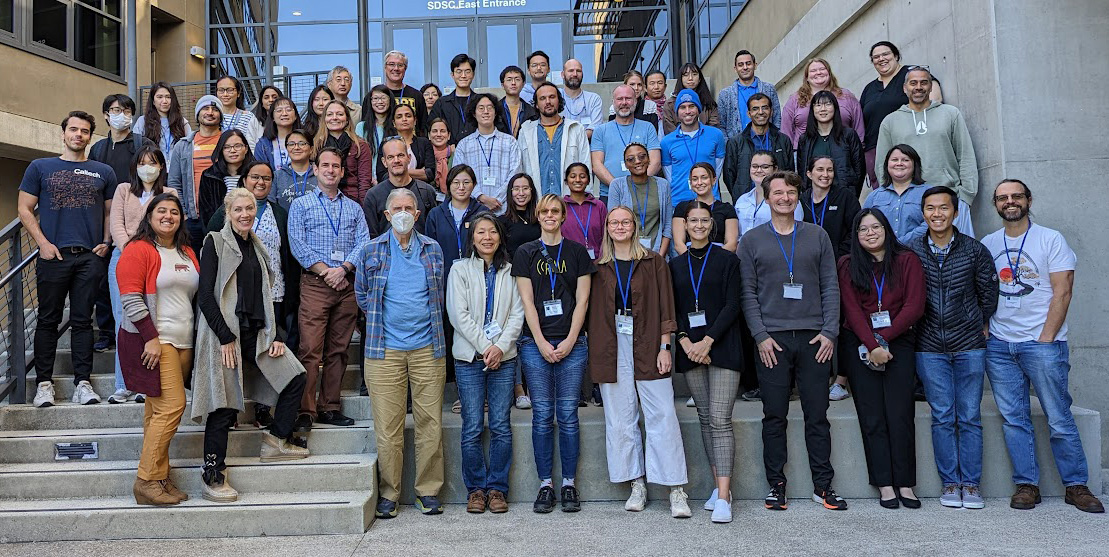 EEGLAB 2022, UC San Diego Supercomputer Center, November 17-21, 2022
EEGLAB 2022, UC San Diego Supercomputer Center, November 17-21, 2022
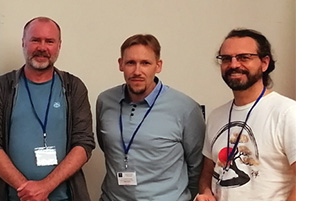 For this “research profile,” we take a look at several EEGLAB 2022 workshop participants in order to see the myriad ways EEGLAB is benefiting current research. Close to 150 attendees descended on the San Diego Supercomputer Center (Nov, 17-21, 2022) to share their research and learn from one another. (Photo to left: Event organizer, Dr. Arnaud Delorme, with Drs. Cyril Pernet and Robert Oostenveld, well known EEGLAB tool developers).
For this “research profile,” we take a look at several EEGLAB 2022 workshop participants in order to see the myriad ways EEGLAB is benefiting current research. Close to 150 attendees descended on the San Diego Supercomputer Center (Nov, 17-21, 2022) to share their research and learn from one another. (Photo to left: Event organizer, Dr. Arnaud Delorme, with Drs. Cyril Pernet and Robert Oostenveld, well known EEGLAB tool developers).
On the surface, the topics represented at the event varied greatly. But these seemingly disparate studies contained a powerful unifying thread. Attendees all depend on the EEGLAB toolbox to process, manipulate, or visualize their research data. (Photo below right: Drs. Tzyy-Ping Jung, Scott Makeig, and John Iversen attend EEGLAB 2022).
Those profiled here include: 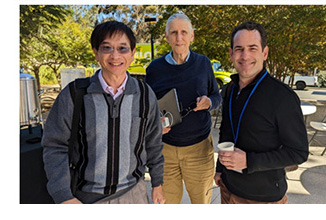 Workshop participant Seyed Yahya Shirazi, Ph.D., who is performing a study to determine the best tailored rehabilitation exercises for stroke patients; Maryam Mahmoudi, Ph.D., who is investigating whether Brain Computer Interfaces (BCI) can help nonverbal people communicate their needs; Deepa Gupta, Ph.D., who analyzes children’s electroencephalography (EEG) data in response to watching a movie; Yu-Shuang Liu, Ph.D., who hopes to track students’ eye movements during tutoring sessions to identify best tutoring strategies; And Talía Román López, Ph.D., who studies the cognitive processes of visual working memory and visual attention. Read more about these scientists and their fascinating research, below. (Photo below, left to right: Drs. Seyed Yahya Shirazi, Maryam Mahmoudi, Deepa Gupta, Yu-Shuang Liu, and Talía Román López).
Workshop participant Seyed Yahya Shirazi, Ph.D., who is performing a study to determine the best tailored rehabilitation exercises for stroke patients; Maryam Mahmoudi, Ph.D., who is investigating whether Brain Computer Interfaces (BCI) can help nonverbal people communicate their needs; Deepa Gupta, Ph.D., who analyzes children’s electroencephalography (EEG) data in response to watching a movie; Yu-Shuang Liu, Ph.D., who hopes to track students’ eye movements during tutoring sessions to identify best tutoring strategies; And Talía Román López, Ph.D., who studies the cognitive processes of visual working memory and visual attention. Read more about these scientists and their fascinating research, below. (Photo below, left to right: Drs. Seyed Yahya Shirazi, Maryam Mahmoudi, Deepa Gupta, Yu-Shuang Liu, and Talía Román López).

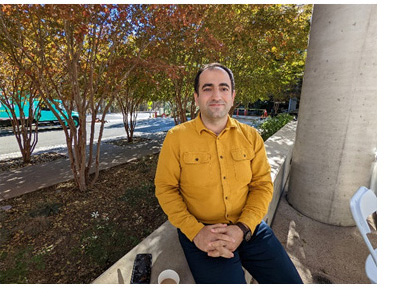 Seyed Yahya Shirazi, Ph.D., recently completed a Postdoctoral position at New York University (NYU). “My main research has been using Mobile Brain/Body Imaging (MoBI) in the field of clinical rehabilitation. We use EEG to look at what we call corticomuscular connectivity or brain-muscle connections as a biomarker for changes in behavior." As an example of this new approach, Dr. Shirazi measures real-time brain signal (EEG or the EEG/EMG combined) while a stroke patient is doing an exercise, so that he can modify the exercise in a personalized manner to benefit that one person. "Because no stroke is the same," he clarifies. "So the rehabilitation shouldn’t be the same, either.”
Seyed Yahya Shirazi, Ph.D., recently completed a Postdoctoral position at New York University (NYU). “My main research has been using Mobile Brain/Body Imaging (MoBI) in the field of clinical rehabilitation. We use EEG to look at what we call corticomuscular connectivity or brain-muscle connections as a biomarker for changes in behavior." As an example of this new approach, Dr. Shirazi measures real-time brain signal (EEG or the EEG/EMG combined) while a stroke patient is doing an exercise, so that he can modify the exercise in a personalized manner to benefit that one person. "Because no stroke is the same," he clarifies. "So the rehabilitation shouldn’t be the same, either.”
Dr. Shirazi joined SCCN in December 2022 to work as a MoBI researcher, first as a Postdoctoral Fellow and then hopefully as a Research Scientist. Like the other workshop attendees, he is a big fan of EEGLAB: “I use EEGLAB on a daily basis, as well as many of the plug-ins, for instance Cleanline, ICLabel, DIPFIT, LIMO, and get_chanlocs,” he shares. “I am also a huge fan of Neuroelectromagnetic Forward Modeling Toolbox (NFT), a MATLAB toolbox for generating realistic head models from available data (MRI and/or electrode locations), and for computing numerical solutions for solving the forward problem of electromagnetic source imaging.” While it will take time for his individualized MoBI approach to move from research to actual clinical use, Dr. Shirazi remains very optimistic, "This approach is very exciting.” (Click here to read more about Dr. Shirazi's exciting research)
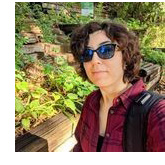 Postdoctoral Associate Maryam Mahmoudi, Ph.D., came to this EEGLAB 2022 workshop to learn EEGLAB basics, but she had an additional reason: To network. “One of my goals is to hopefully find a connection with someone at the workshop who has BCI and EEGLAB technical skills so that we can collaborate as a team,” she explains. “At the University of Minnesota, I am trying to start a BCI project for people who have intellectual and physical disabilities, who cannot communicate verbally. We are hoping to use BCI to recognize brain signals that might be associated with specific words. We would then try to translate the signals to an output so that people can understand what the person is attending to or possibly trying to say.” This idea, she explains, is challenging because little work has been done in this area.
Postdoctoral Associate Maryam Mahmoudi, Ph.D., came to this EEGLAB 2022 workshop to learn EEGLAB basics, but she had an additional reason: To network. “One of my goals is to hopefully find a connection with someone at the workshop who has BCI and EEGLAB technical skills so that we can collaborate as a team,” she explains. “At the University of Minnesota, I am trying to start a BCI project for people who have intellectual and physical disabilities, who cannot communicate verbally. We are hoping to use BCI to recognize brain signals that might be associated with specific words. We would then try to translate the signals to an output so that people can understand what the person is attending to or possibly trying to say.” This idea, she explains, is challenging because little work has been done in this area.
Dr. Mahmoudi hopes that her study (and others) will eventually help improve the quality of life for people who have intellectual and physical disabilities. “It is their right to be able to communicate their needs,” she says with conviction. “There is a spectrum. Even for people who are verbal, there are still some concepts that they cannot express. That leads to frustration. Many of us have experienced that,” she says. “And studies have shown that in those who are unable to speak or express their needs, that frustration can lead to a higher rate of self-injury. So I thought, if we can facilitate this communication, it could help decrease negativity, and improve their feelings and the quality of their lives.” It is this path that led her to UC San Diego. “At this EEGLAB Workshop, I feel like everybody has the exact expertise that I need – like a piece of the puzzle to help make the team complete.”
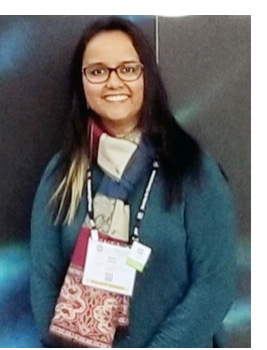
Recently arrived Postdoctoral Scholar and workshop volunteer Deepa Gupta, Ph.D., is analyzing children’s electroencephalography (EEG) data in response to watching a movie. After receiving her Ph.D. from the University of Maryland Baltimore County (UMBC), she was selected as a Postdoc Scholar at the Swartz Center for Computational Neuroscience (SCCN). For the first two weeks at SCCN, Dr. Gupta was reeling with excitement, thinking, “Wow, I’m working working side by side with some of the original developers of EEGLAB (Drs. Makeig, Jung, and Delorme), and with amazing researchers. I’m seeing them in real life and not just on-screen like YouTube!” She pauses, then continues, “Now, it’s settling in, and I am realizing the responsibility here. I am determined to give my best. I see the hard-working students at this workshop who were just like me as a participant, years ago in 2018, when I first came to learn the toolbox. It’s very important, I think, that the EEGLAB toolbox is used correctly with the data and that it comes across to all of us students and EEG enthusiasts.”
Dr. Gupta is quick to sing praises of EEGLAB. She recalls her earlier years in the field: “At UMBC, I started working with long excel sheets that took hours to load,” she recalls. When she found EEGLAB in 2015, she was thrilled. “What took hours in Excel took a matter of seconds in EEGLAB!" She attended her first EEGLAB Workshop in 2018, and has since learned much more about EEGLAB plug-ins and features. “I now use Independent Component Analysis (Makeig et al 1995), plug-ins that include Brain Imaging Data Structure (BIDS), Hierarchical Event Descriptors (HED) (developed by Dr. Kay Robbins), Neuroelectromagnetic Forward Head Modeling Toolbox (NFT) (Acar & Makeig, 2010), and Source Information Flow Toolbox (SIFT) (Tim Mullen). Dr. Gupta’s confidence grew as she learned more about the source localization process, it’s strengths and limits, and what mistakes to avoid while using EEGLAB. “I knew that now I was really on the right track.” So much so, that she is now eager to share some ideas of her own: “I am discussing my ideas with Dr. Makeig, Dr. Delorme, and Dr. Jung to introduce more features that I think will be useful – such as how to improve event data descriptions and more.” She concludes, “For everyone, something drives them. The research to find therapeutic ways of healing from mental health ailments and uncovering underlying brain mechanisms for aiding neurosurgeons and clinicians in medical applications – that's what drives me.” (Click here to learn more about Dr. Gupta's research)
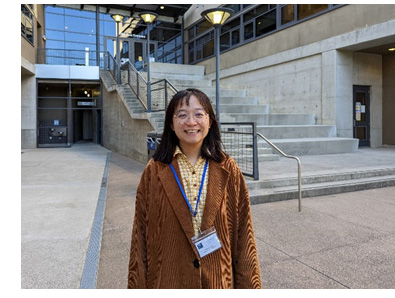 Yu-Shuang Liu, Ph.D., is a Postdoctoral Fellow in the Department of Educational Psychology at the University of Connecticut. She is part of the Lab-to-Classroom research group at UConn’s Neag School of Education. Dr. Liu’s current research involves student learning. There is a dilemma in the field of Education – some feel that too much assistance may not always lead to better outcomes. In her study, students will interact with an online tutor, learning a topic in the field of chemistry. “We are trying to determine how engaged or disengaged students are during the process,” Dr. Liu clarifies. The tutor to which she refers is actually an ‘intelligent tutor’ (computer system) that provides feedback depending on where a student clicks on the screen.
Yu-Shuang Liu, Ph.D., is a Postdoctoral Fellow in the Department of Educational Psychology at the University of Connecticut. She is part of the Lab-to-Classroom research group at UConn’s Neag School of Education. Dr. Liu’s current research involves student learning. There is a dilemma in the field of Education – some feel that too much assistance may not always lead to better outcomes. In her study, students will interact with an online tutor, learning a topic in the field of chemistry. “We are trying to determine how engaged or disengaged students are during the process,” Dr. Liu clarifies. The tutor to which she refers is actually an ‘intelligent tutor’ (computer system) that provides feedback depending on where a student clicks on the screen.
Dr. Liu plans to collect data from 120 high school students, across two studies under the same project. One of the projects will be performed by a collaborator in Israel who will be collecting data there, so that they can compare the data. “Students will be interacting with the tutors and we will record their EEG, skin conductance and heart rate. We use an alpha power to study disengagement. We will also use eye-tracking to study their fixation/gaze and how they interact with the tutor. We will have pre-test and post-test to see how the tutor helps.” Dr. Liu is excited about what her project might show. She adds enthusiastically, “This will be the first time using this online tutor while recording EEG and eye tracking, to measure students’ level of engagement!”
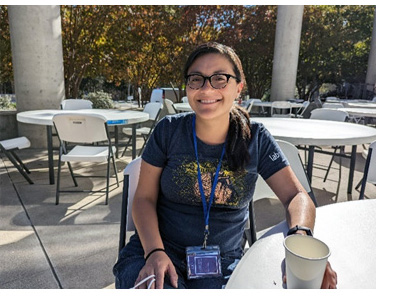 Talía Román López, Ph.D., is a Postdoctoral Fellow at the University of California Los Angeles (UCLA). She is part of the Attention, Brain, and Data Science lab of Dr. Agatha Lenartowicz at UC Los Angeles, and is interested in evaluating different cognitive processes of visual working memory and visual attention. “One of the ways that we can look at the brain surface or scalp,” Dr. Román López explains, “is to look at the posterior regions. And EEG is very useful for that. These are very fast processes,” she continues. “We record EEG because it allows us to measure these dynamics very quickly. It is milliseconds.”
Talía Román López, Ph.D., is a Postdoctoral Fellow at the University of California Los Angeles (UCLA). She is part of the Attention, Brain, and Data Science lab of Dr. Agatha Lenartowicz at UC Los Angeles, and is interested in evaluating different cognitive processes of visual working memory and visual attention. “One of the ways that we can look at the brain surface or scalp,” Dr. Román López explains, “is to look at the posterior regions. And EEG is very useful for that. These are very fast processes,” she continues. “We record EEG because it allows us to measure these dynamics very quickly. It is milliseconds.”
Because EEG is such a central part of her research, Dr. Román López was determined to find the best toolbox to work with her EEG data. “We are using EEGLAB because I think that it’s the most powerful tool to analyze these brain dynamics. The toolbox has a lot of plug-ins that you can utilize, even with different equipment for acquisition.” While attaining her Ph.D. in Mexico City (2015-2020), she was fortunate to find EEGLAB. “I have been working with EEGLAB for at least five years now,” she shares. “When I first started working with EEG acquisition, we had a program called NetStation, and inside that program, you could export your data to EEGLAB.” Dr. Román López has been eager to learn the latest features of EEGLAB in this workshop, so that she can best utilize its power in her exploration of memory and attention.
R. Weistrop, March 2023